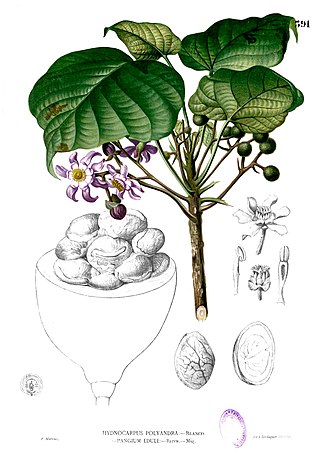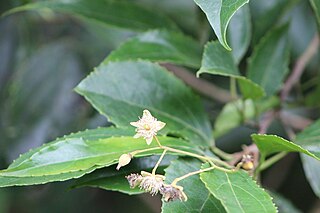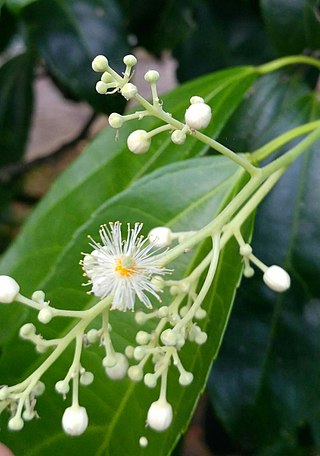Related Research Articles

The Salicaceae is the willow family of flowering plants. The traditional family included the willows, poplar, aspen, and cottonwoods. Genetic studies summarized by the Angiosperm Phylogeny Group (APG) have greatly expanded the circumscription of the family to contain 56 genera and about 1220 species, including the Scyphostegiaceae and many of the former Flacourtiaceae.

The Flacourtiaceae is a defunct family of flowering plants whose former members have been scattered to various families, mostly to the Achariaceae and Salicaceae. It was so vaguely defined that hardly anything seemed out of place there and it became a dumping ground for odd and anomalous genera, gradually making the family even more heterogeneous. In 1975, Hermann Sleumer noted that "Flacourtiaceae as a family is a fiction; only the tribes are homogeneous."

Achariaceae is a family of flowering plants consisting of 32-33 genera with about 155 species of tropical herbs, shrubs, and trees. The APG IV system has greatly expanded the scope of the family by including many genera previously classified in Flacourtiaceae. Molecular data strongly support the inclusion of this family in the order Malpighiales.

Samydaceae is a family of tropical and subtropical woody plants, its best known genus being Casearia. It has always been of uncertain placement, in the past usually being submerged in the family Flacourtiaceae.
Dipentodon is a genus of flowering plants in the family Dipentodontaceae. Its only species, Dipentodon sinicus, is a small, deciduous tree native to southern China, northern Myanmar, and northern India. It has been little studied and until recently its affinities remained obscure.

Macrohasseltia is a monotypic genus of flowering plants in the family Salicaceae. It consists of one species of tree: Macrohasseltia macroterantha, which is native to Central America. Formerly placed in the heterogeneous family Flacourtiaceae, Macrohasseltia is now classified in Salicaceae, along with close relatives Bennettiodendron, Carrierea, Idesia, Itoa, Olmediella, Poliothyrsis, and even the willows (Salix) and cottonwoods (Populus) themselves.
Aphaerema was formerly a genus of flowering plants in the Flacourtiaceae, consisting of one species of small shrubs, Aphaerema spicata, which is native to Brazil and Argentina. Later studies indicated that Aphaerema should be classified in the willow family, Salicaceae, and combined with the genus Abatia. Because the name Abatia spicata was already used, the species was given the new name Abatia angeliana, in honor of Brazilian botanist João Angely. Aphaerema is one of the few groups of Salicaceae with opposite leaves.
Hasseltiopsis is a monotypic genus of flowering plants in the family Salicaceae. It consists of one species of trees: Hasseltiopsis dioica, which is native to Central America. Formerly placed in the heterogeneous family Flacourtiaceae, Hasseltiopsis is now classified in Salicaceae, along with close relatives Prockia, Pineda, Neosprucea, and Banara.

Pleuranthodendron is a genus of flowering plants in the family Salicaceae. It consists of one species of small to medium-sized trees native to the neotropics, specifically Central America and northern South America.

Calantica is a genus of flowering plants in the family Salicaceae. It contains 10 species of shrubs and trees endemic to Madagascar, seven of which are threatened. Calantica is closely related to the pantropical and diverse genus Homalium, from which it differs in having a superior ovary, instead of a semi-inferior ovary. The genus is also similar to Bivinia in its superior ovary but has numerous stamens and long spiciform inflorescences.
Scyphostegia borneensis is a species of shrub or small tree endemic to Borneo. This unusual plant is the only species in the genus Scyphostegia. In many taxonomic classifications the genus was placed in its own family, the Scyphostegiaceae. Analyses of DNA data indicated that the species is related to a group of species of the now defunct Flacourtiaceae, a group which is now placed in a broadly circumscribed Salicaceae.
Euceraea is a genus of three species of shrubs and small trees in the willow family Salicaceae native to the Guiana Shield of northeastern South America. Previously it was treated in the family Flacourtiaceae but was moved along with its close relatives to the Salicaceae based on analyses of DNA data. Euceraea is closely related to the genera Casearia and Neoptychocarpus, but differs in its inflorescences of composite spikes. One species, Euceraea rheophytica, is a rheophyte.
Irenodendron is a genus of three species of shrubs and trees in the willow family Salicaceae native to northern South America. These species were previously treated as a section of the genus Laetia in the family Flacourtiaceae, but the genus Laetia and its relatives were moved to the Salicaceae based on analyses of DNA data. Irenodendron was later hypothesized to be more closely related to the genera Ryania, Trichostephanus, and Piparea due to the presence of an apically divided style, and wood with dark heartwood and large rays; it differs from those genera in having cup-shaped bracts under the flowers and in lacking staminodes.
Osmelia is a genus of flowering plants in the willow family, Salicaceae. Osmelia includes four species of trees native to Sri Lanka and Southeast Asia. Osmelia is closely related to the monotypic Pseudosmelia of Morotai and Halmahera of the Indonesian Maluku Islands and to the monotypic Ophiobotrys from west and west-central tropical Africa.
Zuelania guidonia is a species of shrub or tree native to the West Indies, Central America, and northern South America and is the only member of the genus Zuelania. Formerly classified in the Flacourtiaceae, phylogenetic analyses based on DNA data indicate that this species, along with its close relatives in Casearia, Samyda, Hecatostemon, and Laetia, are better placed in a broadly circumscribed Salicaceae. Zuelania differs from its close relatives in having a large, subsessile stigma.
Pseudosmelia moluccana is a species of shrub or small tree native to Morotai and Halmahera of the Indonesian Maluku Islands and is the only member of the genus Pseudosmelia. Formerly classified in the Flacourtiaceae, phylogenetic analyses based on DNA data indicate that this species, along with its close relatives in the Asian genus Osmelia and the African genus Ophiobotrys, are better placed in a broadly circumscribed Salicaceae. Pseudosmelia differs from its close relatives in having thick, truncate staminodes and large, spindle-shaped fruits with numerous seeds.

Macrothumia kuhlmannii is a species of trees native to Bahia, Espírito Santo, and Minas Gerais states of Brazil and is the only member of the genus Macrothumia. Formerly classified in the genus Banara in the family Flacourtiaceae, phylogenetic analyses based on DNA data indicate that this species, along with its close relatives in Ahernia, Hasseltia, and Pleuranthodendron are better placed in a broadly circumscribed Salicaceae. Macrothumia differs from its close relatives in having a congested fascicle- or umbel-like inflorescence and a large fruit. The genus name is derived from the Greek word μακροθυμία, which means long-suffering and enduring patience.

Prockia is a genus of flowering plants in the family Salicaceae. It consists of approximately six species of shrubs and small trees native to the West Indies, Mexico, Central America, and South America. Its type species, Prockia crucis, is highly polymorphic and has a broad distribution, from Mexico and the West Indies to Uruguay and northern Argentina.
Tetrathylacium is a genus of two species of shrubs and small trees in the family Salicaceae native to the southern Central America and northern South America. Previously it was treated in the family Flacourtiaceae but was moved along with its close relatives to the Salicaceae based on analyses of DNA data. Tetrathylacium is rather unique in the Samydaceae in having tightly arranged panicles of spikes, four sepals and stamens, and non-arillate seeds. The stems are often inhabited by ants, and T. macrophyllum is suspected to have locust pollination.
Hecatostemon completus is a species of shrub or tree native to northeastern South America and is the only member of the genus Hecatostemon.
References
- ↑ Lemke, David (1988). "A synopsis of Flacourtiaceae". Aliso. 12: 29–43. doi: 10.5642/aliso.19881201.05 .
- ↑ Chase, Mark W.; Sue Zmarzty; M. Dolores Lledó; Kenneth J. Wurdack; Susan M. Swensen; Michael F. Fay (2002). "When in doubt, put it in Flacourtiaceae: a molecular phylogenetic analysis based on plastid rbcL DNA sequences". Kew Bulletin. 57 (1): 141–181. doi:10.2307/4110825. JSTOR 4110825.
- ↑ Alford, Mac (2006). "Nomenclatural innovations in Neotropical Salicaceae". Novon. 16 (3): 293–298. doi:10.3417/1055-3177(2006)16[293:niins]2.0.co;2.
- ↑ Alford, Mac (2008). "Revision of Neosprucea (Salicaceae)". Systematic Botany Monographs. 85: 1–62.
- ↑ Sleumer, Hermann (1954). "Flacourtiaceae". Flora Malesiana. Series I, Spermatophyta. 5: 1–106.